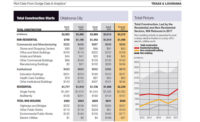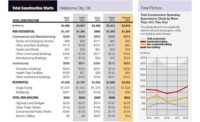We are surviving because in good times we are conservative and in bad times we are conservative,” says John Thompson, vice president of local JE Dunn Construction, which is building Four Partners Place at Oklahoma University. The $39-million, 75,000-sq-ft facility, scheduled for completion in 2012, includes offices and a data center.
The Devon tower is the only new office building under way at the city’s core, but many other new buildings are going up within a 2-sq-mile area. Further, two other big energy producers—SandRidge Energy Inc. and Chesapeake Energy Corp.—are helping to underwrite the civic programs, along with Devon.
SandRidge started a $100-million rehabilitation of its downtown headquarters across three city blocks. Construction is also under way on the Chesapeake Finish Line Tower, a $5-million, four-story project in the boathouse district—a present from SandRidge to the city.
The Oklahoma Medical Research Foundation is building a $125-million, 186,000-sq-ft tower, with 24 rooftop wind turbines. Flintco is expecting to finish the building in 2012.
Regional Work
Manhattan is nearly finished building the $103-million Cancer Research Institute at the Oklahoma University Health Sciences Center. Also on the university campus, Manhattan is building the $8.5-million Anne and Henry Zarrow School of Social Work and an $8.5-million expansion of the Fred Jones Jr. Museum of Art. Both are scheduled to open next year.
Centennial Builders, a joint venture of Manhattan Construction and Flintco, plans to complete the $160-million, 125,000-sq-ft American Indian Cultural Center & Museum in 2015.

MAPS was first approved in 1993 as a $309-million program. The $360 million it raised through taxation was supplemented by about $1 billion in private investment; projects include a central library, a minor-league ballpark, an entertainment district and other public works. In 2001, voters approved the $700-million MAPS for Kids, for school construction projects.
There was never wild speculation in Oklahoma City, which helped soften the recession’s blow. The region did not realize a large spike in construction activity before the recession and therefore missed the deep fall, says Carl Williams.
Further, “The banking/oil-and-gas downturn that happened in Oklahoma City in the 1980s made a lasting impact on our banking community, and its more conservative outlook also provided some protection,” says Roy Williams.
Cornett adds, “We’ve been conservative. … We learned our lessons in the 1980s, when things bottomed out quickly.”
There is more work to do to complete the mayor’s vision for the city. For example, downtown retail is scarce. Cornett has ambitions to build a National Football League stadium, though the city has no team. Landing an NFL franchise and retail development are both “tricky goals,” says Cornett.
“The convention center, the streetcar [system]—they almost ensure another decade of prosperity,” he adds.



